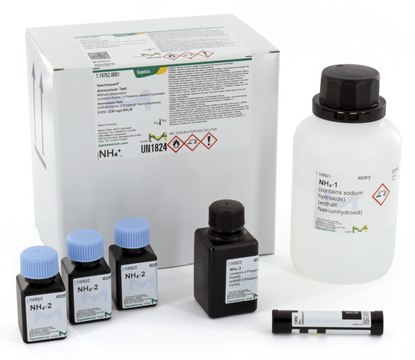MAK434
Acetaldehyde Assay Kit
Sufficient for 100 colorimetric tests
Sign Into View Organizational & Contract Pricing
All Photos(1)
About This Item
UNSPSC Code:
12161503
NACRES:
NA.84
Recommended Products
Quality Level
input
cell culture medium
tissue
serum
urine
food(s)
beverage(s)
plasma
application(s)
agriculture
cosmetics
environmental
food and beverages
detection method
colorimetric
relevant disease(s)
gastrointestinal diseases
storage temp.
−20°C
General description
Acetaldehyde (CH₃CHO) is a commonly found aldehyde in nature and widely used in various industries. It is a metabolic byproduct of ethanol in the liver and is toxic to the human body. However, it is rapidly converted to the less harmful acetic acid by the enzyme aldehyde dehydrogenase. Individuals deficient in aldehyde dehydrogenase experience accumulation of acetaldehyde upon alcohol consumption, leading to facial and body flushing known as alcohol flush reaction or “Asian flush syndrome.” Acetaldehyde buildup has also been linked to alcohol-related hangover effects. Despite its classification as a carcinogen, acetaldehyde is naturally present in many foods and beverages such as ripe fruit, coffee, and wine.
Application
The Acetaldehyde Assay Kit may be used for:
- Alcohol Metabolism Research
- Hepatology Research
- Neurological Research
Features and Benefits
- Simplified Process: Enjoy a hassle-free procedure that requires the addition of a single working reagent and only a 30 minute assay room temperature reaction, saving you time and effort.
- Convenient and Sensitive: Uses only 20 µL of sample for the determination of acetaldehyde with a detection range of 2 µM to 2mM.
- High-Throughput Compatibility: Seamlessly integrate our kit into high-throughput handling systems, ensuring efficiency and accuracy.
Suitability
The kit is suitable for acetaldehyde determination in biological samples (e.g. plasma, serum, urine, tissue and culture media) and food/beverage samples (e.g. wine, coffee, and juice).
Principle
The Acetaldehyde Assay Kit is based on the aldehyde dehydrogenase catalyzed oxidation of acetaldehyde with the reduction of NAD to NADH. The formed NADH subsequently reduces MTT, producing a colored formazan compound. The intensity of the end product color, measured at 565 nm, is directly proportional to the acetaldehyde concentration in the sample.
Other Notes
For additional information on our range of Biochemicals, please complete this form.
Signal Word
Warning
Hazard Statements
Precautionary Statements
Hazard Classifications
Eye Irrit. 2 - Skin Irrit. 2
Storage Class Code
12 - Non Combustible Liquids
Regulatory Information
常规特殊物品
含少量动物源组分生物产品
Choose from one of the most recent versions:
Certificates of Analysis (COA)
Lot/Batch Number
Don't see the Right Version?
If you require a particular version, you can look up a specific certificate by the Lot or Batch number.
Already Own This Product?
Find documentation for the products that you have recently purchased in the Document Library.
Our team of scientists has experience in all areas of research including Life Science, Material Science, Chemical Synthesis, Chromatography, Analytical and many others.
Contact Technical Service

